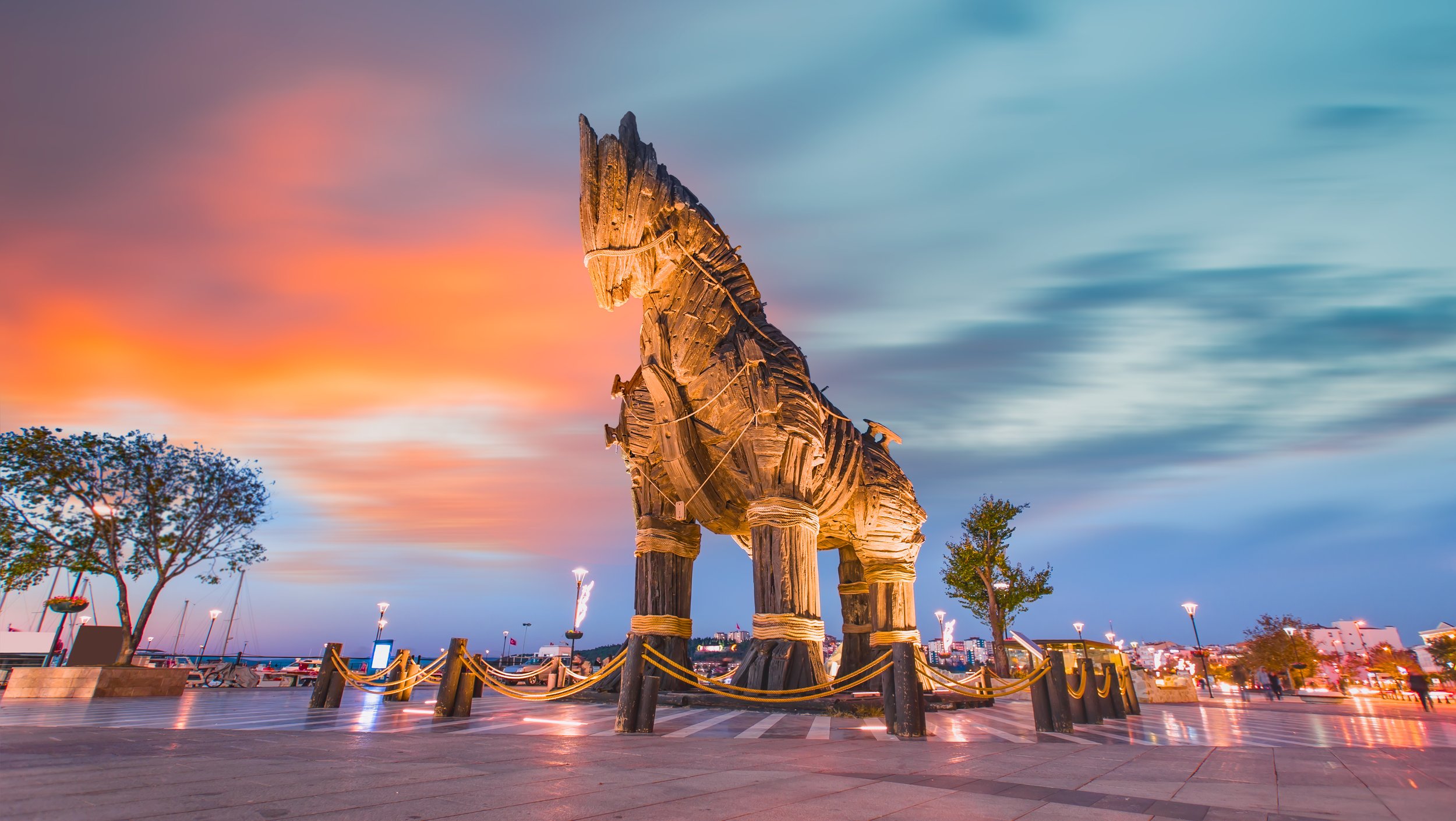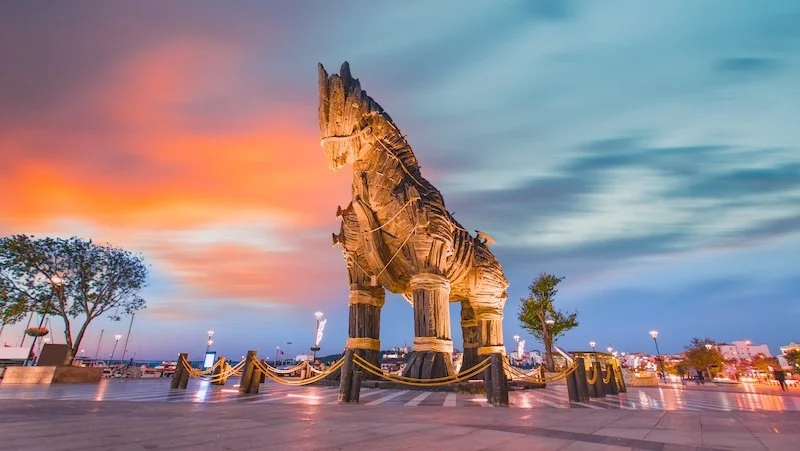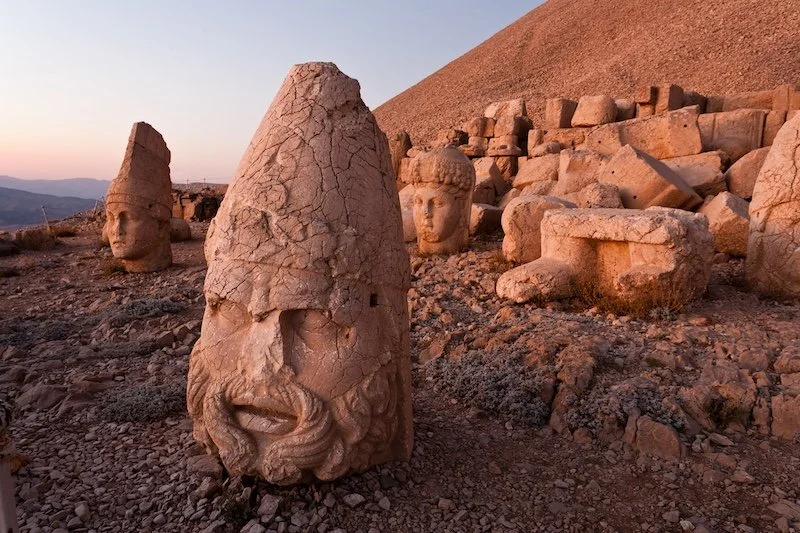
Participating countries
Fly2Troy is the gateway for VFR flights to Türkiye
To promote tourism and civil aviation in Türkiye.
Türkiye is undoubtedly one of the most fascinating countries in the world, not least because of its thousands of years of important history. So it's no wonder that over 50 million tourists visit the country every year. However, one important aspect of tourism has always been missing here. Civil sport and hobby pilots are not yet familiar with the country. We want to change this with Fly2Troy by overcoming the bureaucratic hurdles and offering a unique VFR trip through the country. Our aim is also to strengthen civil aviation in Türkiye and promote the exchange of knowledge and experience.
Video used with kind permission of @gez.dolas.kesfetOur fantastic route in Türkiye
-

1. UNESCO World Heritage Site Troy
Who doesn't know the historical legend of the Trojan Horse - a Greek fleet sails to the East. It is to bring Helen, the most beautiful woman in the world, who has been abducted to Troy, back to Greece. This is how the most famous and oldest epic in world literature describes it: the Iliad. - This place is near Canakkale. - Hollywood has already filmed the legendary story with Brad Pitt, and it is precisely this Trojan horse that appears in the film that is exhibited in Canakkale.
-

2. UNESCO World Heritage Site Ephesus
Ephesus was one of the most important and largest cities of the Roman Empire. The first settlements in the city area date back to around 5000 BC. Ephesus is also significant in connection with the development of Christianity. The New Testament mentions the Letter to the Ephesians, which the Apostle Paul wrote to the Christians of the city. According to legend, Mary settled in Ephesus with the apostle John after Jesus' ascension and taught many people healing there. Mother Mary's death house, on a hill above the city, is today a place of pilgrimage, which we will also visit.
-

3. UNESCO World Heritage Karain Cave
There is nothing like it in world history: Karain Cave was always inhabited from the Palaeolithic period over 500,000 years ago until the Byzantine period. Karain Cave is very important because it can shed light on how the first humans came from Africa to Anatolia. This is very significant for the study of human civilisation. There are three large chambers in the cave, separated by calcite walls, stalagmites and stalactites and connected by narrow passages. The Palaeolithic period has three phases: the Old Palaeolithic, the Middle Palaeolithic and the Late Palaeolithic. Neanderthals lived in the Middle Palaeolithic period. Neanderthal teeth and skulls have been found in Karain Cave. Drawings and tools, as well as human and animal bones from every phase of the Palaeolithic are on display.
-

4. UNESCO World Heritage Site Zeugma
In ancient times, Zeugma was a city located on the western bank of the Euphrates. On the other bank was Seleukeia Apamea. Because of its pontoon bridge, the twin city was an important stop on the Silk Road. The mosaic had lain dormant underground for almost 2000 years until scientists found it. The ancient city became an archaeological sensation in 2000, when experts from all over the world excavated almost 50 valuable mosaics in a rush action and saved them from destruction by the rising waters of a reservoir. Since then, Zeugma has been considered the "second Pompeii" because of the preserved treasures. The "gypsy girl", who experts believe to be a companion of the god of wine Dionysus, became world-famous and, to a certain extent, the cover girl of antiquity.
-

5. UNESCO World Heritage Site Göbekli Tepe
The megalithic structures of Göbekli Tepe are among the oldest structures of mankind in the world. Created at a time when hunter-gatherers became sedentary farmers, the structures offer unique information about life over 11,000 years ago. This find has once again rewritten the history of mankind. It is also the oldest temple of mankind. To accomplish these logistical feats, hundreds of workers, artists and constructors had to be fed, clothed and equipped. And they had to stay in this place for a long time, perhaps even for many years. Did they settle down for this reason? If so, the construction of the temple could have initiated the Neolithic Revolution, the greatest turning point in human history. Because everywhere in the fertile region from the eastern Mediterranean to Mesopotamia and Iran, people will soon settle in villages for the first time, grow grain, breed sheep, goats and cattle.
-

6. UNESCO World Heritage Site Nemrut
The throne of the gods. One of the most incredible stone testimonies to human ambition. On top of the mountain rises a monumental combination of sanctuary and tomb. It was built by the late Hellenistic king Antiochos I Theos (69-36 BC) of Commagene. The sanctuary was to be the centre of a new religion that combined Persian and Greek mythology. Shortly after his coronation, Antiochos gave himself the name Theos (God), an unusual self-deification even in the context of the Hellenistic ruler cult. In two long Greek inscriptions, the king specified how exactly he was to be worshipped during his lifetime and after his death. On his father's side, he traced his lineage back to the Achaemenid Great Kings Darius I and Xerxes I, and on his mother's side to the Seleucids with Alexander the Great as his ancestor.
-

7. Sumela Monastery
The Sumela Monastery is one of the most famous sights in Turkey and is one of the most important religious sites in the country. It is located on the slopes of Mount Mela in Trabzon province and was founded by Byzantine monks in the 4th century. The monastery is known for its impressive architecture, its frescoes and its location in a stunning natural setting. Sumela Monastery played an important role in the history and culture of the region. It was an important place of religious and cultural activities and served as a centre for the Orthodox faith. Over the centuries, the monastery was destroyed and rebuilt several times, making it a symbol of the resilience and will to survive of the people in the region.
-

8. UNESCO World Heritage Site Cappadocia
Light grey pointed caps, hats made of basalt, chimneys in which, according to legend, fairies lived - in the middle of Anatolia, nature has created a bizarre landscape that could have come straight out of a fairytale land. - The history of Cappadocia dates back to 6500 BC, when the first evidence of human settlement was found. Since then, the region in central Turkey has experienced a turbulent history whose diverse cultural legacies still fascinate visitors today. After the Hittites settled in Cappadocia from 1600 BC, the Phrygians came in 800 BC, then the Medes, who were quickly replaced by the Persians. After a period of Macedonian rule, Cappadocia came under Roman influence around 200 BC and was annexed under Tiberius in 17 AD. From the 3rd century onwards, the region rose to become one of the most important centres of early Christianity, as witnessed today by the numerous rock-hewn churches with their unique frescoes and images. Here we walk underground in the footsteps of the beginnings of Christianity, which once played such a special role as a religion in Cappadocia. Important saints such as St. Jerome or St. George - patron saint of horsemen - come from Cappadocia.
-

9. Sivrihisar Airpark
S.H.M. (Airpark & Museum) may not be a historical site, but it is nevertheless the most unique, fascinating and therefore most important aerodrome in Turkish civil aviation. Its founder Ali Ismet Öztürk is the first professional national aerobatic pilot in the history of Türkiye. He has built a magnificent airfield with an aircraft museum and in this museum (M.S.Ö. Aviation and Space Museum) there are incredible historic aircraft that cannot be found anywhere else on earth, because all the aircraft are airworthy and therefore ready for flight at any time. This makes the museum the first of its kind that can fly. For example, 1940 Douglas DC-3, 1940 Boeing Stearman A75N1 / PT-17 or 1944 North American P-51D Mustang "Ferocious Frankie" and many other aeroplanes.

10. ISTANBUL - A cosmopolitan city like no other
The absolute highlight at the end: special permission for a low overflight over the Bosphorus at the Golden Horn! Europe on the right and Asia on the left with a view of the continent-connecting bridges and the Hagia Sophia. Breathtaking!
Our last stop brings us to the World Heritage City of ISTANBUL - A cosmopolitan mega-city with over 16 million inhabitants. Between Orient and Occident, it connects not only continents, but also cultures and religions.
Istanbul is one of the oldest continuously existing cities in the world. Dorians (Greeks) settled here in 660 BC. The settlement soon grew into a flourishing trading city over which changing rulers fought. Sometimes it was the Persians, sometimes Sparta, sometimes Athens. To fend off the attacks, it joined the rising Roman Empire as a confederate. For 400 years, Byzantium enjoyed relative independence until the Roman Empire annexed the city and soon gave it a new name: Constantinople. In 1453, the Ottomans conquered the city, which was then called Konstantiniyye. It was only after the founding of the Turkish Republic by Atatürk that the name was changed to Istanbul in 1930. The word Istanbul is derived from the 10th century from "Stan" and "Pol" which means inside the old city wall.









